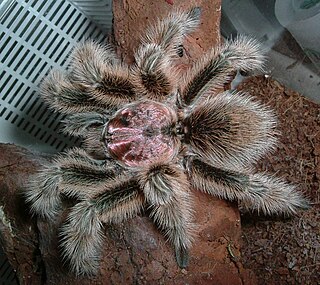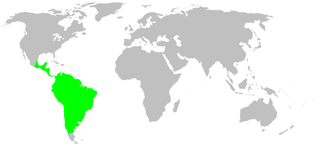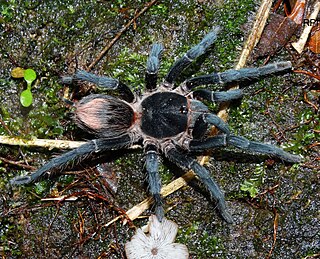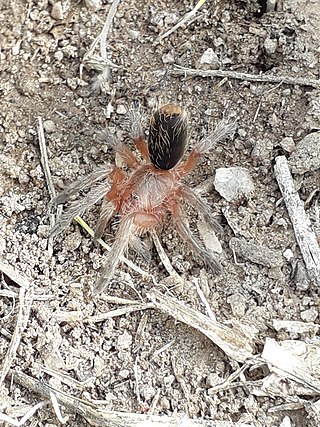
Avicularia is a genus of the family Theraphosidae containing various species of arboreal tarantulas. The genus is native to Panama, the Caribbean, and tropical South America. Each species in the genus has very distinguishable pink foot pads.

Grammostola is a genus of South American tarantulas that was first described in text by Eugène Louis Simon in 1892. These medium- to large-sized spiders are native to tropical South America, and are usually brown in color, with pinkish or orangish-red hairs. The very docile Chilean rose tarantula is popular as a beginner's spider among tarantula enthusiasts.
Cândido Firmino de Mello-Leitão was a Brazilian zoologist who is considered the founder of Arachnology in South America, publishing 198 papers on the taxonomy of Arachnida. He was also involved with education, writing high-school textbooks, and contributed to biogeography, with essays on the distribution of Arachnida in the South American continent.

Actinopus is a genus of mygalomorph spiders in the family Actinopodidae. It was first described by Josef Anton Maximilian Perty in 1833 from the type species Actinopus tarsalis found in Brazil. The name is derived from Greek actin- "ray, beam" and pous "foot". It is a senior synonym of Aussereria, Closterochilus, Pachyloscelis, and Theragretes.

Diplura is a genus of South American curtain web spiders that was first described by C. L. Koch in 1850. It is found in South America and Cuba belonging to the subfamily Diplurinae.

Pamphobeteus is a genus of tarantulas that was first described by Reginald Innes Pocock in 1901. It includes some of the largest spiders in the world. They are found in South America, including the countries of Peru, Bolivia, Ecuador, Brazil, Colombia and Panama.

Phormictopus is a genus of spiders in the family Theraphosidae (tarantulas) that occurs in the West Indies, mainly Cuba and Hispaniola, with three species probably misplaced in this genus found in Brazil and Argentina.

Tarantulas comprise a group of large and often hairy spiders of the family Theraphosidae. As of December 2023, 1,100 species have been identified, with 166 genera. The term "tarantula" is usually used to describe members of the family Theraphosidae, although many other members of the same infraorder (Mygalomorphae) are commonly referred to as "tarantulas" or "false tarantulas". Some of the more common species have become popular in the exotic pet trade. Many New World species kept as pets have setae known as urticating hairs that can cause irritation to the skin, and in extreme cases, cause damage to the eyes.

Senoculus is a genus of araneomorph spiders in the family Senoculidae, and was first described by Władysław Taczanowski in 1872. It is the only genus in the family Senoculidae.

Cyriocosmus is a genus of tarantulas that was first described by Eugène Louis Simon in 1903. They are small to medium spiders, with a bicolored or one same color carapace.
Cyclosternum is a genus of tarantulas that was first described by Anton Ausserer in 1871.

Tapinauchenius is a genus of tarantulas that was first described by Anton Ausserer in 1871. The name is a combination of the Greek ταπεινός, meaning "low", and αὐχήν, meaning "neck". In 2022, the genus Pseudoclamoris was transferred to Tapinauchenius.

Acanthoscurria is a genus of tarantulas that was first described by Anton Ausserer in 1871. They are found throughout South America including the countries of Argentina, Bolivia, Brazil, Ecuador, French Guiana, Guyana, Paraguay, Peru, Suriname and Venezuela, plus into the Windward Islands West Indies,.

Sericopelma is a genus of tarantula, found in Central America from Nicaragua to Panama. The limits of the genus and its distribution have long been confused; it is closely related to the genus Aphonopelma. Sericopelma species are among the largest found in Central America. They can be kept as pets, although at least one species has been described as "very aggressive".

Holothele is a genus of tarantulas that was first described by Ferdinand Anton Franz Karsch in 1879. Originally placed with the curtain-web spiders, it was transferred to the tarantulas in 1980.

Homoeomma is a genus of South American tarantulas that was first described by Anton Ausserer in 1871. It is considered a senior synonym of Calopelma, Butantania, and of Cyclothoracoides. These tarantulas are usually quite small and usually burrow a few centimeters under a rock or log.

Megaphobema is a genus of tarantulas that was first described by Reginald Innes Pocock in 1901. They look similar to members of Pamphobeteus except for its legs; the third and fourth pairs of legs are much larger and stronger than the first two pairs.

Plesiopelma is a genus of South American tarantulas that was first described by Reginald Innes Pocock in 1901. Plesiopelma species are particularly abundant along mountainous ranges, frequently living under stones. Both males and females live in silk tubes under stones with aggregate spatial distribution. The walls of these tunnels are covered by waterproof silk, protecting them from floods. In addition, there is a uniform saturated microclimate inside the tunnel, which protects the spiders from dehydration.
Schismatothele is a genus of South American tarantulas that was first described by Ferdinand Anton Franz Karsch in 1879.
















